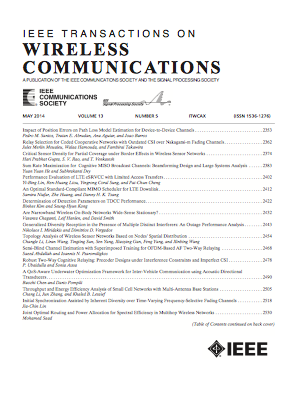多网关多波束卫星系统的双时标联合地面预编码和星载波束形成设计
IF 10.7
1区 计算机科学
Q1 ENGINEERING, ELECTRICAL & ELECTRONIC
引用次数: 0
摘要
研究了存在馈线链路干扰的多网关多波束卫星通信中地面预编码和星载波束形成联合设计问题。与纯地面系统相比,混合地面机载架构在总吞吐量和馈线链路带宽要求之间提供了很好的权衡。此外,我们提出了一种双时间尺度设计策略,大大减少了卫星有效载荷的计算负担。其中,基于统计信道状态信息(S-CSI)设计长期星载波束形成网络(BFN),优化星载波束形成网络,设计短期星载预编码矩阵,满足瞬时信道状态信息(I-CSI)。我们提出了一个包含BFN无损约束和卫星平均功率约束的平均和速率最大化问题。为了解决这种双时间尺度非凸随机优化问题,我们提出了一种称为双时间尺度地面和机载联合波束形成(TJGBB)的算法。每次迭代时,TJGBB算法首先基于加权最小均方误差(WMMSE)方法求解短期地面预编码子问题。然后,对长期机载波束形成主要问题的目标和约束条件构造凸替代函数,创建一个近似版本。最后,通过求解该凸近似问题对长期变量进行更新。该算法在可接受的误差范围内收敛到原问题的平稳解。仿真结果表明,与现有方案相比,我们提出的方法可以显著提高系统的整体吞吐量。本文章由计算机程序翻译,如有差异,请以英文原文为准。
Two-Timescale Joint On-Ground Precoding and On-Board Beamforming Design for Multi-Gateway Multibeam Satellite Systems
This paper studies the joint on-ground precoding and on-board beamforming design problem in multi-gateway multibeam satellite communications with feeder link interference. Compared with pure on-ground systems, the hybrid on-ground on-board architecture provides a good trade-off between the total throughput and the bandwidth requirements of the feeder link. Moreover, we propose a two-timescale design strategy which significantly reduces the computational burden on the satellite payload. To be specific, the long-term on-board beamforming network (BFN) is designed based on the statistical channel state information (S-CSI), while the short-term on-ground precoding matrices are designed to cater to the instantaneous CSI (I-CSI) with optimized on-board BFN. We formulate an average sum rate maximization problem which incorporates the lossless constraint of the BFN, as well as the average power constraints at the satellite. To tackle this two-timescale non-convex stochastic optimization problem, we propose an algorithm called two-timescale joint on-ground and on-board beamforming (TJGBB). At each iteration, the TJGBB algorithm first solves the short-term on-ground precoding subproblem based on the weighted minimum mean square error (WMMSE) method. Then, it constructs convex surrogate functions for the objective and constraints of the long-term on-board beamforming primary problem, creating an approximate version. Finally, the long-term variables are updated by solving this convex approximation problem. The proposed algorithm is proven to almost surely converge to a stationary solution of the original problem within an acceptable error margin. Simulations show that our proposed method can significantly improve the overall system throughput compared to existing schemes.
求助全文
通过发布文献求助,成功后即可免费获取论文全文。
去求助
来源期刊
CiteScore
18.60
自引率
10.60%
发文量
708
审稿时长
5.6 months
期刊介绍:
The IEEE Transactions on Wireless Communications is a prestigious publication that showcases cutting-edge advancements in wireless communications. It welcomes both theoretical and practical contributions in various areas. The scope of the Transactions encompasses a wide range of topics, including modulation and coding, detection and estimation, propagation and channel characterization, and diversity techniques. The journal also emphasizes the physical and link layer communication aspects of network architectures and protocols.
The journal is open to papers on specific topics or non-traditional topics related to specific application areas. This includes simulation tools and methodologies, orthogonal frequency division multiplexing, MIMO systems, and wireless over optical technologies.
Overall, the IEEE Transactions on Wireless Communications serves as a platform for high-quality manuscripts that push the boundaries of wireless communications and contribute to advancements in the field.

 求助内容:
求助内容: 应助结果提醒方式:
应助结果提醒方式:


